Here are some tools we use on the airplane project in lieu of the usual tools for that purpose. We’ll probably elaborate on that at the Van’s Air Force Forum, where people building these planes hang out, but we thought that these are odd enough and in most cases versatile enough that gunsmiths, sport shooters, and even home handymen will find them useful.
We’ve listed them in order of coolness — the degree to which they delighted and surprised us.
Black and Decker Gyro Screwdriver
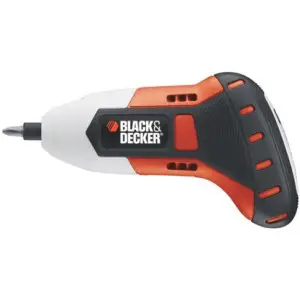 The Gyro is not your usual electric screwdriver. For one thing, it has a now-considered-anemic 4 watts, so if you’re driving wood screws into heart of oak, this is not your tool. But for another, it has a unique user interface in the crowded screwdriver market. There’s no on-off or directional switches.
The Gyro is not your usual electric screwdriver. For one thing, it has a now-considered-anemic 4 watts, so if you’re driving wood screws into heart of oak, this is not your tool. But for another, it has a unique user interface in the crowded screwdriver market. There’s no on-off or directional switches.
No switches, —-es!? How the heck does it work?
It works by a flick of your wrist. Righty-tighty? Flick your wrist clockwise. Lefty-loosey? Counterclockwise. (Anticlockwise, you Brits). How cool is that?
Not cool enough. Because it works on a proportional flick of your wrist. Want it to turn fast, flick hard and fast. Slower? You got it, slower and gentler. The whole thing is apparently controlled by the solid-state micro-accelerometers that are now getting embedded in phones and every other gadget.
Screwdriver, hell, this is the tool you want for driving deburring tools. Like this single-flute deburring tool or this long-shafted one from Cleaveland Aircraft Tool. It’s so natural to control the Gyro by wrist motion, and when you have to deburr thousands of #30 holes again after redrilling them to real #30 size — thank you, Hertel, not — your thumbs will thank you. The use of the driver feels weird at first but you quickly master it and have control you don’t have with a conventional power driver.
Best yet, in our deburring use it runs for weeks on a single battery charge.
The Black & Decker page also includes a comment from a guy who’s as delighted with his Gyro as we are, and he’s a reloader, using his for case trimming and chamfering and all that good stuff.
We really liked this tool so much that the Blogbrother hied himself to Lowe’s where we bought it, for, if we remember right, $18 and change, looking to get another. He texted back from the store:
Clearance priced for $15 [bleep]
Texted him back; why’s such a great tool on clearance? The clerk tells him that they did not sell; people thought they were a weird idea, and nobody wants a 4w screwdriver any more. We hope that B&D keeps pressing this technology into the market. Buy it, you will love it. We’re going to buy another just to keep in the package in case one of ours gives up the ghost.
Clecall Cleco Pliers
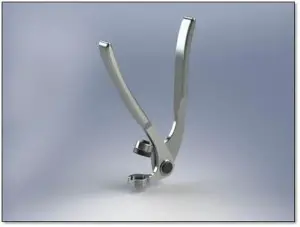 If you don’t ever make anything from sheet metal, you will probably never see a cleco, a small, removable fastener that sits in rivet or bolt holes, temporarily holding things together. If you make an airplane, you will handle dozens or hundreds of them thousands of times. (They also come in handy on other stuff. We just used riveted aluminum to make a replacement part for a wastebasket top latch, and we used clecos to hold the parts together while we drilled holes through two parts). The pinlike Clecos are attached and removed by a small plier that has not changed since Lindbergh’s day. Until the Clecall was released recently.
If you don’t ever make anything from sheet metal, you will probably never see a cleco, a small, removable fastener that sits in rivet or bolt holes, temporarily holding things together. If you make an airplane, you will handle dozens or hundreds of them thousands of times. (They also come in handy on other stuff. We just used riveted aluminum to make a replacement part for a wastebasket top latch, and we used clecos to hold the parts together while we drilled holes through two parts). The pinlike Clecos are attached and removed by a small plier that has not changed since Lindbergh’s day. Until the Clecall was released recently.
We saw this advertised in Kitplanes magazine — a wishbook for plane builders, like we are now, and wannabees, like we’ve been for the past 30 years or so — and thought, it can’t be as great as what they claim for it, can it? They say:
– Faster to use. Easier to Activate
– 70% lighter than normal cleco pliers at 4.3 oz!
– Vertical profile installs clecos in tight areas with ease!
– CNC machined and anodized in the USA for strength!
– Reduce fatigue and wrist pain
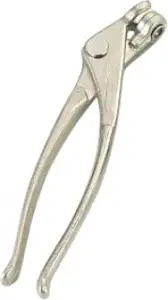
Boo, hiss: the old Cleco pliers. On the plus side, they’re only six bucks. On the minus side, you can get a Clecall now, so it would be six wasted bucks..
And all that seemed over the top. But there are times when we’re working side by side and each of us could use a Cleco pliers, so we ordered this instead of the 1920-whatever version. Turns out, every one of those claims is true. We love this so much that we never use the old one any more. Instead of both of us Clecoing, we’re back to one guy waiting for the pliers again.
Fortunately, the company just introduced a new version, made of forged steel, with some other improvements. We love the alloy one, but we have to try the new one too.
And just to add a dose of awesome sauce, the guy who invented it built an airplane assembled like ours (a Zenith, designed by Chris Heintz) and prototyped the tool by 3D printing. We wanna meet this guy and tell him how much we love his pliers. Not in a gay way or anything. NTTAWWT.
Buy it at Cleaveland Aircraft Tool (they only have the alloy version so far, but try them on the phone).
But ’em at Aircraft Spruce & Specialty (they are showing both versions).
Graco-Croix CX-9 Sprayer
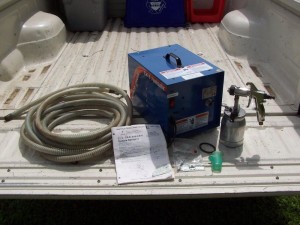
This is somebody else’s, off of eBay. It’s the same model, but ours is nasty with overspray. We’ve gotta get a welder cart or something for hauling it.
When we were looking at how to wash, edge, prime and paint parts we initially concluded we needed a compressor. This led to fits of depression, because a compressor good enough to drive a spray gun isn’t something you buy at Lowe’s or Home Depot. It’s an expensive purchase and a loud bastard to boot. Sure, we could use a lot of other air tools with a compressor like that, but most air tools, including the pneumatic version of the cleco tool, and pneumatic rivet tools, can be used with a less strong compressor.
Cruising Craigslist for bargains, we found this sprayer. Checking it out, it seemed like a turbine sprayer was the answer to all our paint problems. Could that really be true?
So far, we’re very pleased with it. A local painters’ supply can get us parts, not that we’ve needed much; we needed a gasket, but made one of neoprene. We’re still running it with the contractor (coarse) spray gun innards, not the automotive (finer) ones. And the filter is old, but it’s user-cleanable.
It’s very environmentally friendly, “spraying” a cone of air around its paint. It’s quiet; we can converse in normal tones while spraying, unless we have to raise our voices: “What did you just spray me for, you featherbrained imbecile?” And it seems to be very economical with etcher, primer, and paint, which is good news because that stuff is X-pensive with a capital X these days.
We improvised a dust booth from one of those folding canopies you buy at big-box stores, and hang the parts from the canopy frame and a couple of cross clotheslines using hooks bent from old clothes hangers. (So we’re actually using hangers to build something that will go in a hangar).
Our success with the CX-9 turbine sprayer is an illustration of something we’ve long believed, a used professionals’ tool is generally a better buy than a new hobbyists’ tool.
Rockwell Tools BladeRunner
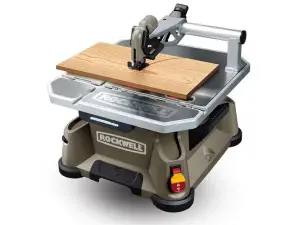 But this one? A hobbyist’s tool, from conception to delivery. Nonetheless, it’s an oddball tool we do use. The BladeRunner is a small saw that we use in lieu of a band saw. Fundamentally, it’s the guts of a jigsaw mounted, fixed, inverted in a lightweight plastic table. There’s an upper level guide that incorporates rollers to keep the blade on track, and has a socket to which you can attach a shop vac for a clean work space.
But this one? A hobbyist’s tool, from conception to delivery. Nonetheless, it’s an oddball tool we do use. The BladeRunner is a small saw that we use in lieu of a band saw. Fundamentally, it’s the guts of a jigsaw mounted, fixed, inverted in a lightweight plastic table. There’s an upper level guide that incorporates rollers to keep the blade on track, and has a socket to which you can attach a shop vac for a clean work space.
Compared to a bandsaw, it gives up a great deal of versatility and power, but it’s small and lightweight. The big plus is that blades are readily changeable. It uses any t-shank jigsaw blade. We use a saw mostly for cutting wood for jigs and fixtures, and secondarily for separating parts supplied joined together, so the ability to change from a wood blade to a metal blade in seconds, and the ability to dial speed up and down with a thumb wheel, are wonderful. (Changing speeds on the average bandsaw takes a lot longer and requires monkeying with pulleys and math. Changing blades is a pain in the neck).
Saw cuts are usually rough cuts with a poor surface finish, so we tend to put a lot of finish work in when we cut aluminum parts with this saw. It would not work on steel parts, so it’s not a good gunsmithing tool. It’s great for most of the things we do, though; for example, Van’s tends to supply a group of brackets or components of a built-up hinge as a long strip of angle that’s only partly cut to shape. It’s left for the kit builder to separate the four or six parts from one another. With care, it’s possible to make these cuts close enough that the edge can be cleaned up with just a red Scotchbrite pad.
(The Rockwell blade marked “aluminum,” by the way, sucks at cutting aluminum. Use the one marked “metal.” Don’t even think about using it on steel. The saw has a speed dial on it, though, so maybe it could be made to work. But the bandsaw is supported at both ends, and only goes one way, and that rigidity and consistency can’t be matched in a plastic-framed tool that grips a reciprocating blade at one end).
The current version, the BladeRunner X2, is even smaller, lighter, and less expensive than the older one we have. (The illustration we used is the old model). Someday we’ll find the right price on a used variable-speed metal-cutting bandsaw, and then this guy will be retired to just do the woodwork. But right now, he’s a member of the plane-making family.

Kevin was a former Special Forces weapons man (MOS 18B, before the 18 series, 11B with Skill Qualification Indicator of S). His focus was on weapons: their history, effects and employment. He started WeaponsMan.com in 2011 and operated it until he passed away in 2017. His work is being preserved here at the request of his family.

7 thoughts on “4 Weird Airplane Tools We Use Every Day”
Gosh, you should get into the marketing racket. I don’t even have a particular need for a Black and Decker Gyro Screwdriver, but I’ve decided I just have to have one.
I can think of lots of uses for the Gyro. My Lowe’s is out, but the one 20 miles up the road has them. Should I get all three in stock? Hmm.
I’m jones’n for the Bladerunner X2, could never justify a band saw, but this looks like something that will get lots of use.
Dewalt makes a screwdriver with the gyro operation. One of the guys at work bought one and loves his. I’m not sure it works exactly the same, but maybe this is another choice for you with the added benefit of having one battery always charged. http://www.dewalt.com/8vmax-gyroscopic-technology-screwdriver
It sounds similar. It’s more versatile, I think, with its external battery and more power. The B&D Gyro is more compact. We could see both in our toolboxes; can’t wait to show the Dewalt page to the Blogbrother (we were washing parts with Eko-Clean this morning, he’s coming back to etch and prime this afternoon…)
http://chopperhandbook.com/tools.htm
Damn, now I wanna build a motorcycle too. Or maybe another plane, with a welded steel frame. The tubing notcher a lot of plane framers use is called The Ol’ Joint Jigger. I dunno if it’s better, but it’s advertised in Sport Aviation and Kitplanes.
WM, I built a vertical band saw using a Milwaukee portable band saw. You know, the hand held saws used for cutting pipe, tube and raw stock?
Pretty simple to do, with your industriousness you could build one in a new York minute.
What I did was to remove the tamped fence which keeps the saw steady against the material being cut, used a .375″ slab of 6062, bolted with handmade brackets under this platen to the available factory mounting points. Oh ya, you have to cut a narrow curf slot for the blade. The trigger hand handle is very rugged composite, I clamp it in my bench vise. No need to use much clamping force, lot of traction between the composite and vice jaws. I removed the trigger and made a pedal out of 10ga mild steel sheet stock.
Sounds funky, but believe you me, this is a righteous little saw. Starts sells cobalt alloy blades in a range of teeth counts, they are superlative cutting blades. Nothing comes close, I know, tried everything out there. I have used this saw for almost 20 years, and used it to build stainless steel race exhaust systems, chrome moly race chassis, and titanium exhausts and chassis too. A full time business for 7 years, and the red for part Tim and every sundry fabrication project also.
Only draw back to this dandy of a saw is the length of cut because of the body of the saw motor is in the way. They did angle the blade so the maximum possible cut could be obtained, but there is no getting around it being there. You can cut from both sides of a piece of material to double the kerf length. But for anything 8 inches and under, this is a gem of a saw. I have not had to repair or replace a single thing on this saw in twenty years. I do have extra bits like wheel rubbers, blade guide bearings and brushes around in case. Haven’t needed them yet. I’ve built a couple for friends and they love them. The Starret blades are pricey in comparison, but no other brand comes close. Thin wall Ti, 304, 321, 4130, and inconel tubing is brutal on saw blades, the Starret’s are of an alloy which not only keeps its edge like nothing else, they don’t strip teeth, even if you loose a tooth or three, they won’t cascade strip like all the other makes. Even Lenox blades can’t compare.
This little saw probably made me a couple hundred thousand dollars in orders believe it or not. Oh, and the OEM trigger I made into the foot control is variable speed. A real handy aspect. This saw looks funny, and has that Rube Goldberg charm, but is world class all the way. You can find the Milwaukee’s cheap at pawn shops. Most have very low hours. I think Ai checked into the Porter Power units, they looked like they would work as well too. I purchased mine new, reason being is there are two models, they offer two cutting capacities, got the model with the deeper cutting capacity. Another practical aspect is it only uses the foot print your vice uses, takes seconds to mount or remove, I have a hanger on the wall, don’t even unplug it, so its ready in a jiffy. I usually order blades off McMaster Carr. They always have had the cobalt alloy Starret blades in stock. The 12 tooth blades cut aluminum alloy like a dream. Oh, and I have a tube of Castrol cutting/grinding wax, the stuff used for carbide cutting burrs like for cylinder head porting, really helps on the softer materials.
Hope this helps you son way. Your always turning me onto new things and ideas.